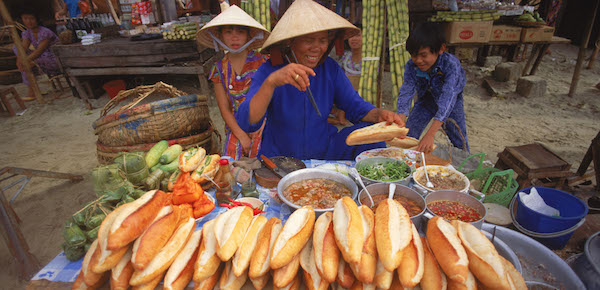The Marvel of Bánh Mi
In the colonial era the Vietnamese appropriated French baguette and added local ingredients to concoct a sandwich that is now a hit with the patrons of restaurants and food trucks from Singapore to San Francisco.

Vietnamese vendor selling bánh mì, Nha Trang, Feb. 12, 2004. Tim Hall/Alamy
Adjacent to Nhà Thờ Đức Bà, Saigon’s Notre Dame Cathedral, there was a kiosk that sold a favorite sandwich of my Vietnamese childhood. Customers would travel far and wide for this delicious item, the bánh mì, which seemed stuffed with treasures like an old lady’s bulging purse. It was an airy French baguette with a thin crunchy crust that could contain a cornucopia of roast chicken or pork, homemade pâté, cured ham, headcheese, a mélange of pickled daikon radish and carrot, slices of cucumber and chili pepper, a generous sprinkling of cilantro leaves, a few dashes of Maggi sauce, and a spread of mayonnaise (which, for some reason, Vietnamese call bơ, which means butter). At once spicy, salty, sour, savory, sweet, and aromatic: a bite into a bánh mì on a Saigon street was a moment of rapture.
How could I have imagined then, in wartime Vietnam, that bánh mì would one day become an international sandwich sensation, a culinary wonder of our globalized age? It has spread from Saigon to California and from there to the rest of the planet. Every city in North America now has its own bánh mì shop or chain: Bánh Mì Saigon in New York, Bun Mee in San Francisco, BONMi in Washington, DC, Bánh Mì Bá Get in Chicago, Bánh Mì Boys in Toronto. Bánh mì is standard food truck fare from San Diego to Boston. Yum! Brands, owner of Kentucky Fried Chicken, Taco Bell, and Pizza Hut, has opened Bánh Shop fast-food outlets in Dallas. South of the border in Mexico City is a bright red and yellow bánh mì food truck called Ñham Ñham. Shops and chains have sprung up everywhere else; in London there is Kêu!, Bánhmì11, and, next to St. Paul’s Cathedral, Banh Mi Bay. Among the options in Shanghai is Mr. V, whose menu includes the Obscene Double Triple—bánh mì with headcheese, Vietnamese sausage, and peppercorn terrine; in Singapore, you can try Bánh Mì 888; one of the busiest in Tokyo is a place simply called Bánh Mì Sandwich.
The sandwich is sprouting in the fancier restaurants run by top chefs, who are having fun taking bánh mì to more serious culinary heights. Richard Landau, chef-owner of Vedge in Philadelphia, has brainstormed the Quinoa Burger Bánh Mì. Denver’s No. 1 chef, Lon Symensma of Cho Lon, came up with the idea of a deconstructed bánh mì spread across a charcuterie board: duck terrine, foie gras, pickled daikon, and carrot, and Chinese mustard-mayonnaise with cilantro. Top chef Michael Voltaggio of ink. on Melrose Avenue in Los Angeles offers two varieties, a veggie bánh mì with barbecued tofu and mushroom spread, and a bánh mì with pork shoulder, bacon, chicharrónes, and onion spread.
Non-Vietnamese chefs regularly reinterpret bánh mì on the Food Network, the queen of American taste Martha Stewart teaches her viewers how to make it, upscale Whole Foods supermarkets line it into their deli counters, and celebrity chefs reveal their bánh mì secrets in Food & Wine and other culinary periodicals. Anthony Bourdain featured bánh mì on his No Reservations program—typically, the clip showed the chef, author, and television personality munching on a sandwich from a Hanoi street stall. The craze has inspired countless blog sites, including one called Battle of the Bánh Mì: Finding, Feasting, & Making Vietnamese Sandwiches. Foodies post dueling bánh mì recipes on websites like Blue Apron and Epicurious. “You know your food is great when Americans sell it back to you,” a friend of mine once quipped.
L’Indochine Française
Bánh mì’s origins, as its architectural foundation indicates, are in France. The French arrived in Vietnam initially as missionaries in the seventeenth century and established colonial control of Vietnam in 1887 with the formation of La Fédération Indochinoise. The French brought their language and their food, including eventually the baguette, the long thin loaf of bread that became popular in France in the early twentieth century. Growing up in Hanoi my grandmother called it bánh tây, literally Western-style bread. By the 1950s the Vietnamese started to tinker with it and, signaling Vietnamese appropriation of the baguette, started calling it bánh mì—simply, wheat bread. Some recipes called for a mix of rice flour with the wheat flour. The aim was to make it fluffier than the French baguette, allowing it to be easily stuffed with Vietnamese delights.
Bánh mì has long been a food staple of the working poor. Bánh mì stalls and carts are everywhere in the streets of Vietnam, providing simple and delicious sustenance, typically for breakfast or the midday meal, to the masses. It was street food long before street food became an obsession with foodies—in those days, some well-to-do Vietnamese shunned street vendors out of concern about typhoid fever and other illnesses. Ingredients like the sweet, crunchy fresh vegetables and pungent herbs and spices are what make the bánh mì Vietnamese. An essential component of the Vietnamese way is Maggi sauce, a Swiss-made savory seasoning introduced by the French.
Bánh mì could be found in the communities of Vietnamese students and émigrés in France from the 1950s onwards. The traiteur Hoa Nam in the thirteenth arrondissement of Paris has been selling bánh mì wrapped in wax paper for years, although the foodie trend in bánh mì is now evident in bobo (bourgeois and bohemian) spots on the Right Bank like Saigon Sandwich and Bulma. But it was the mass exodus of Vietnamese with the Fall of Saigon in 1975 that propelled the Vietnamese sandwich on its way to global stardom. In no time, refugees in the United States were opening Vietnamese restaurants, bakeries, and delicatessens, offering up all the dishes from the homeland—including bánh mì—for fellow refugees and curious American diners alike.
Some trace bánh mì’s cultural migration to the sandwich’s burst of popularity in California’s Silicon Valley. Vietnamese refugees eager to build new lives in America had flocked to the area to work in the booming high-tech industry’s assembly lines. In 1980, a man called Lê Văn Bá and his sons parked a food truck outside a computer manufacturing plant, targeting Vietnamese who couldn’t go far or spend much for lunch. Lê, a wealthy sugar merchant who had lost everything in the Communist takeover of South Vietnam, sold the cheapest fare around, including Vietnamese baguette sandwiches. It didn’t take long before bánh mì caught on with non-Vietnamese workers as well as local college students.
By 1983, Lê’s sons, Chieu and Henry, turned the success of the sandwich into Lee Bros. Foodservices, Inc.—the family Americanized their name to Lee—which today serves more than five hundred independently owned food trucks throughout northern California. The business also evolved into Lee’s Sandwiches, a fast food chain of dozens of shops selling bánh mì from San Francisco to Houston. Cathy Chaplin, author of the Food Lover’s Guide to Los Angeles, once blogged, “If there was a Lee’s Sandwiches for every McDonald’s, the world would be a better place.” Indeed, when Lê died, his obituary in the San Jose Mercury News called him the Ray Kroc of Vietnamese sandwiches.
Bánh mì’s meteoric rise in the past few years is probably best explained by a convergence of pop-culture food trends in the United States—the popularity of food trucks dishing up tasty and inventive street food, the explosion in food blogging, the phenomenal success of television cooking shows, and the advent of the celebrity chef. The bánh mì craze has produced an authority on the subject, Andrea Nguyen, a northern California writer whose blog, Viet World Kitchen, explores the culinary traditions of Vietnam as well as of Asia more broadly. She published The Bánh Mì Handbook: Recipes for Crazy-Delicious Vietnamese Sandwiches, which made National Public Radio’s list of best cookbooks of 2014.
“Vietnamese bánh mì offers a wealth of textures,” Nguyen told me. “Crispy bread! Fatty mayo and meats! Crunchy pickles! Hot chilies! Refreshing cucumber and herbs!” Nguyen attributes bánh mì’s crossover appeal to its familiarity and adaptability. “It’s pretty, not overly mysterious for people interested in exploring new cuisines,” she says. “It’s varied in fresh vegetables, light flavors, and people can more or less identify what they’re eating. Vietnamese cuisine blends East Asia with Southeast Asia, South Asia and the West. Bánh mì is the perfect hybrid.” One of her recent blog posts: “Laughing Cow Cheese Omelet Bánh Mì Recipe.”
Pauline Nguyen, owner of the Red Lantern, Sidney’s top Vietnamese restaurant, sees the bánh mì’s attraction in its exquisite taste. “Let’s face it, the traditional French baguette with jambon, a bit of fromage, and possibly some cornichon, doesn’t quite compare,” she says. “You have a beautiful balance of the sweet and piquant of pickled vegetable, the heat of chilies, and richness of the pâté and mayonnaise, along with the unctuousness of the pork terrine, the aromas of the coriander and spring onion, and of course the texture of crisp baguette.”
Just as the cheap price drew Vietnamese to bánh mì, says Minh Tsai, CEO of the Hodo Soy tofu business in Oakland, it is one of the reasons for its spreading interest among non-Vietnamese. He explains that bánh mì was quickly recognized as a bargain because Americans always perceived Vietnamese food as tasty yet inexpensive. For the same reason, he adds, phở, the Vietnamese noodle soup, likewise has become a ubiquitous dish across America.
In the United States in the 1990s, bánh mì was still sold mostly within the Little Saigon enclaves in California and a few southern states. Competition among the small Vietnamese establishments made us wonder how they managed to survive. I remember the “Mua Hai Tặng Một”—Buy Two Get One Free—promotions in the fast food shops of San Jose, which became home to the second-largest Vietnamese population outside Vietnam. Here bánh mì became a favorite of young Americans, including the local college students, looking for a snack or throwing a small party.
“It was all about volume and cheap labor,” says Steve Do, among the boat people who fled Vietnam for the United States in the 1980s, who found financial success in real estate and Internet technology stocks. “I lived with bánh mì while going to high school and college, and I knew several families who worked in the business,” he told me. “Families working together making sandwiches eliminate labor cost—even underage kids make sandwiches after school to help the family out. Often the stores don’t hire anyone but Vietnamese newcomers who work under the table while still on government subsidies. It’s the refugee way, but it works.”
Grandma’s Cá Kho Tộ
Nations take pride in and gain identity from their cuisines. What would France be sans pot-au-feu, England without roast beef and Yorkshire pudding, or Italy deprived of spaghetti? Yet, a mark of all things culinary is an ability to adapt and transform. Various historians and writers put the origins of pasta in Greece, Arabia, and if the legend of Marco Polo’s role in bringing it to Europe is to be believed, China. The tomato prized in Italian sauces today appears to have arrived from South America with returning conquistadors.
Appropriation and adaptation are survival instincts for Vietnamese, a land coveted by others and repeatedly colonized and dominated throughout the last thousand years. The Vietnamese language is an amalgamation of French, Chinese, local dialects of Khmer, Hmong, and Cham, and an array of other local tribal tongues. Atop a traditional Vietnamese altar you’ll find various Buddhas, faded images of grandpa and grandma, and statues of Taoist saints. This combination of Mahayana Buddhism, Confucianism, and Taoism known as tam giao is the result of efforts to integrate religious ideas that arrived in the country over the millennia. Ancestor worship is mixed with yearnings for Buddhist nirvana while the temporal world is measured through the Taoist flow of life force known as the qi.
Then there is the story of Vietnam’s indigenous religion, Cao Dai, established in the mid-1920s, which goes so far as to integrate and reconcile the world’s major religions. In its cosmos it perceives Hinduism, Judaism, Zoroastrianism, Buddhism, Taoism, Confucianism, Christianity, and Islam all as human efforts to worship and communicate with the one Supreme Being. It numbers Moses, Joan of Arc, Louis Pasteur, Victor Hugo, Sun Yat-Sen, Jesus Christ, and the Vietnamese poet Trạng Trình among its many prophets and saints. Graham Greene, in his Vietnam novel The Quiet American, called Cao Dai the “prophecy of planchette,” as its spiritualists receive messages of wisdom from the various saints in séances.
Little wonder that we would see a mixture in Vietnamese cuisine as well. In bò kho, or beef stew, to cite but one example, there’s beef, carrot, and tomato brought by the French, curry powder from India, cinnamon from Ceylon, star anise from China, and chilies, lemongrass, and fish sauce from Vietnam itself. If you feel like it, pour in a little red wine from Bordeaux, it will still work beautifully. Vietnamese cooking thrives on integrating new ingredients to achieve new balances. What is invention, after all, if not one part theft and two parts reinterpretation?
The adaptive tradition lives on in the Vietnamese diaspora. Take this dish my paternal grandmother used to make: cá kho tộ: clay pot catfish, simmered in pork fat, caramelized fish sauce, and lots of black pepper, something originating in the Mekong Delta ages ago. Grandma once made this dish in Daly City, a working-class suburb of San Francisco where we first came to live as refugees. It caused such a stink to our neighbors’ noses they called the fire department about a toxic smell. Mortified, we apologized and kept our windows closed whenever Grandma prepared her favorite recipes. Today, however, patrons wait up to three weeks for a table at San Francisco’s most celebrated Vietnamese restaurant, The Slanted Door, owned by chef Charles Phan, where the same dish that Grandma liked to make is served to appreciative diners, albeit now paired with a light-bodied and smoky pinot noir.
What once seemed quixotic, or even toxic, has thus become an American classic. Private culture, perhaps especially in California, has a knack of spilling into the public domain. A few decades ago, who would have imagined that sushi—raw fish—would join the burger as an indelible part of American cuisine? Or that curry powder and soy sauce would be found down Aisle 3 at every Safeway? Or that an entirely new taste—umami, Japanese for savory—would become part of American culinary idiom?
The San Francisco Bay Area is a global table, where tastes and experiments go hand in hand. I still have an article published a decade ago in the San Francisco Chronicle that declared, “America’s mean cuisine: More like it hot—from junk food to ethnic dishes, spicy flavors are the rage.” It’s a reminder of the adulterous nature of the Californian palate. Californians were among the first in the United States to give up blandness and savor pungent lemongrass in their soup, to develop a penchant for that tangy, burnt taste of spicy chili. “There are 15.1 million more Hispanics living in the United States than there were 10 years ago, and 3.2 million more Asians and Pacific Islanders,” noted San Francisco’s newspaper of record. “And the foods of those countries—longtime favorites with Californians—are now the nation’s most popular.”
Sriracha, the king of chili sauce, is threatening to usurp ketchup as the American condiment of choice. It was invented by David Tran, another Vietnamese refugee among the boat people, who became a multimillionaire on his blend of garlic powder, distilled vinegar, and fresh red jalapeño. The green-capped bottle graces the kitchens of the world cuisines from Chinese to Japanese, Mexican to French, Moroccan to Indonesian. Tran and his Sriracha sauce are quite a testament to the adaptability of people, cuisine, and culture in our global age.
If bánh mì survives as common street food in Vietnam today, I imagine that some vendors are unaware of how Việt Kiều—Vietnamese overseas—took the sandwich on to international fame and glory. I remember the Vinh Chan boulangerie in Dalat, the windblown and foggy hill station lined with French villas and pine trees where I grew up. A Frenchman opened the bakery in the 1930s. Every afternoon around 4 p.m. there was always a line of customers, enticed by the sweet aroma of freshly baked bread permeating the air. The warm and crunchy baguettes came out of the oven to a chorus of oohs and aahs. Vinh Chan was known for its divine French sandwich—a baguette served with thin slices of cured ham, cucumber, a dab of butter, and a little salt and pepper. In my child’s mind, this was a sandwich superior to the bánh mì I tasted in Saigon. Such was the colonial hangover that what was French was intrinsically better than what was reinvented by us, the Vietnamese. Now I can take comfort in knowing that millions of food lovers around the world enjoy their baguette sandwiches—fixed in the Vietnamese way.
Andrew Lam is editor and co-founder of New America Media, an association of more than three thousand ethnic media outlets in the United States. He is the author of Perfume Dreams: Reflections on the Vietnamese Diaspora, East Eats West: Writing in Two Hemispheres, and most recently, a collection of short stories, Birds of Paradise Lost. On Twitter: @andrewqlam.



